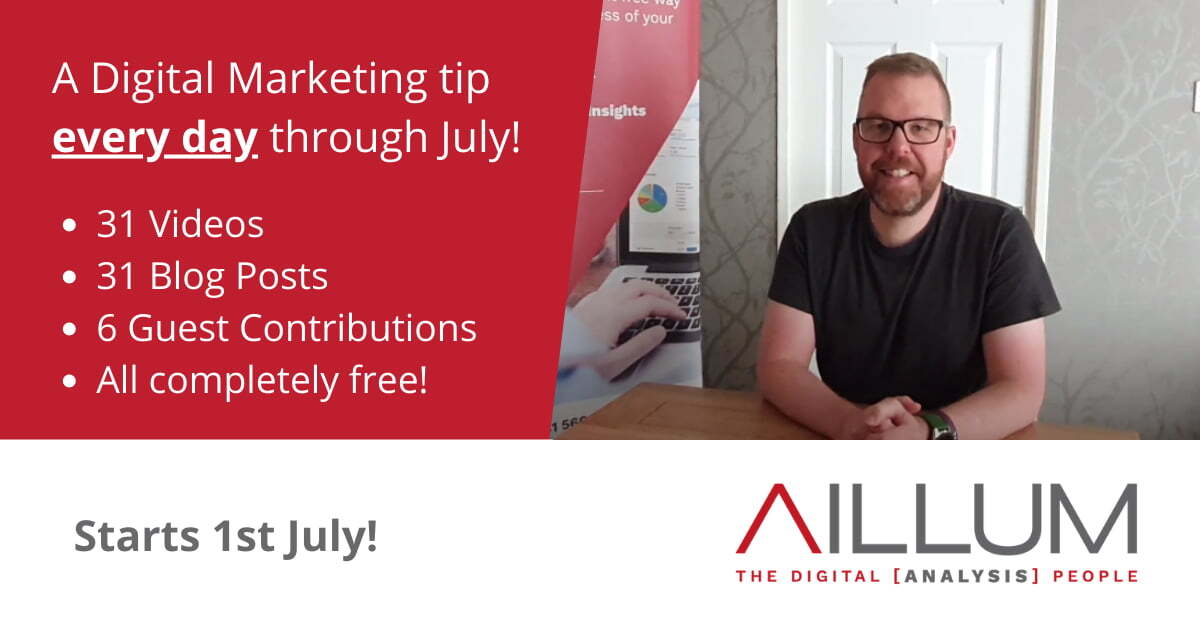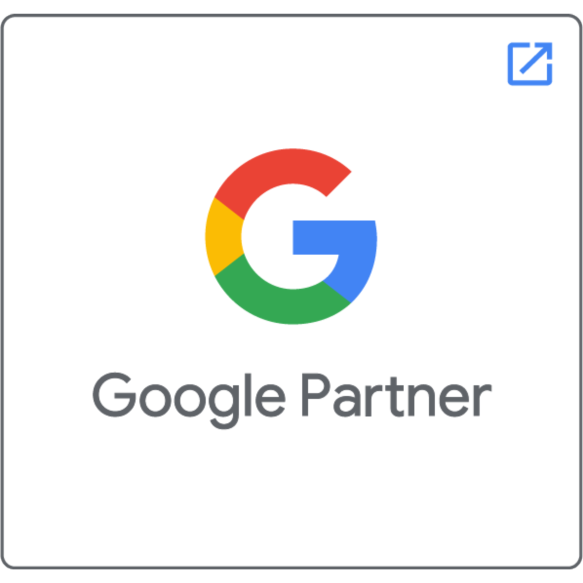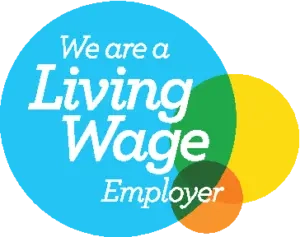We turned 10 years old as a business on 1st July 2020! Thank you to all our clients, colleagues, partners and friends for your support over the years!
To celebrate, and to help businesses improve their digital marketing as we all slowly came out of lockdown, we decided to give away some tips and advice, completely free!
All tips listed below, with links to individual blog articles … or watch the YouTube playlist
31 Digital Marketing Tips – the list!
01: Make sure Google Analytics is setup and running on your website.
Our first tip, as expected, is focused on data collection. Not always easy to setup and understand, so this first tip is all about getting the basic Google Analytics tracking code on your website. Find out more >
02: Optimise your Headlines using Headline Analyzer
Our second tip looks at trying to reduce website Bounce Rates and increase Click Through Rates from marketing emails, social posts, ads and more by optimising your headlines. Find out more >
03: GUEST TIP! Use Adobe Colour Wheel and Google Fonts to help improve your design
Our third tip is brought to us by guest Michael Melvin from Melvin Creative. Melvin Creative is a Graphic Design company based in Glasgow City Centre, and Mike offered some time to provide a couple of tips focused on colour and font selection as part of your branding and design. Find out more >
04: Review and Optimise your LinkedIn Profile Headline
The LinkedIn Headline is one of the most prominent parts of your LinkedIn profile, appearing in multiple places across the LinkedIn interface. So Tip 4 in our series is all about reviewing your headline and ensuring it’s optimised. Find out more >
05: Review and Optimise your Facebook Page About Tab
The About Tab is often an under optimised part of a Facebook Business Page. Minimum information entered during setup to allow you to move on with posting content and building followers. So tip 5 is focused on reviewing that About Tab, and adding as much content as you can to it. Find out more >
06: Ensure Search Console is Setup and Running on your Website
We’re always surprised just how little Google Search Console is used by businesses. It’s an incredibly useful tool, with great insights into your organic search performance. With reports on keywords, pages and errors, tip 6 is all about getting search console setup and running on your website. Find out more >
07: GUEST TIP! Use Followerwonk to get more detailed Analytics from your Twitter Account
Our 7th tip is brought to us by guest Gary Ennis from NS Design. NS Design are well known for their specialist Social Media training, and Gary kindly offered some of his time to discuss some of the benefits of using Followerwonk to better understand your Twitter performance. Find out more >
08: Speed up your Website by Optimising your Images
Improving the loading speed of your website can have multiple benefits: lower bounce rates, higher conversion rates and improved rankings in search engines being just a few. So tip 8 is all about tackling a common quick win when it comes to site speed: Optimising images. Find out more >
09: Make Hashtag use easier by building your own Hashtag lists!
“Hashtags! Which should I use? How many? Which are best? Don’t they take forever to find and type? Too confusing … I’ll just not bother using them!”. Tip 9 is all about making hashtags easier to use, by cutting down the research time long term. Find out more >
10: Stop Allocating Friday Afternoons to work on your Digital Marketing!
While not true in all cases, Friday is typically seen as winding down time. Studies show we’re less productive as the working week progresses. So tip 10 is more of a “don’t do”, than a “do do”. If you want to see more success from Digital Marketing, stop scheduling it for Friday afternoons! Find out more >
11: Start using Google Trends to help with Keyword Research
Keyword Research is important. Understanding how users search, when they search and what language / terminology variations they use can be incredibly helpful when it comes to writing content, producing ads and writing social posts. Tip 11 aims to get you started on your keyword research journey, free! Find out more >
12: Usability – Make Website Phone Numbers and Email Addresses Clickable
A fairly easy tip to discuss, though maybe not overly easy to implement depending how your website has been built. Tip 12 looks at a simple aspect of usability, making it easier for potential customers to contact you, by ensuring email addresses and phone numbers on your website are clickable. Find out more >
13: Use Google Analytics Annotations to keep Notes of your Digital Marketing Activities
Posting on social media, sending emails, running paid ads, writing blog posts, adding images, offline events, COVID-19? There are so many activities and events that could influence the performance of your website and conversions. Tip 13 is about using the Annotations feature of Google Analytics to keep track of those activities. Find out more >
14: GUEST TIP! Register your TikTok Username and Familiarise yourself with the Platform now!
Our 14th tip is brought to us by Colin Kelly from Comsteria. With so many companies still unsure how TikTok could fit within their business, Colin kindly gave some of his time to offer some excellent tips to get you started and interested in the potential of the platform. Find out more >
15: Heat Mapping – Setup Easy-To-Use Visual Reports on Website User Behaviour
Not everyone wants to review rows of data and metrics. You should, but we appreciate not everyone wants to or has the time. Heat Mapping offers a quicker / visual way to evaluate user behaviour. So tip 15 is all about setting up a free heat mapping account and getting started. Find out more >
16: Facebook Insights Posts Report – Use it to help develop a posting schedule
Over the years we’ve seen a lot of hands go up when we ask who uses Facebook for business, but not so many go up when we ask who uses Facebook Insights – the analytics behind your activity. So tip 16 is all about trying to get you starting to look, by introducing the Posts Insights report. Find out more >
17: GUEST TIP! Organise your Digital Marketing with Google Calendar and Google Forms
Our 17th tip is brought to us by Gordon Kedslie from Cobry! With remote working on the increase, Gordon kindly gave some of his time to offer some tips on how G Suite tools (Calendar and Forms) can improve scheduling, organisation and consistency of your Digital Marketing. Find out more >
18: Use Negative Keywords to Reduce wasted spend on Google Ads
Not everyone uses Google Ads. We love it, but we hear a lot of comments from businesses trying it themselves, that it costs a lot of money and generates a lot of irrelevant clicks. So tip 18 focuses on the Negative Keyword feature to help drive up efficiency of your budget. Find out more >
19: Signup to a Bookmarking Tool and Organise your Digital Marketing Research!
We hope you’re finding this series of tips useful, but you should also be doing other research as part of bringing your business out of Lockdown and improving your Digital Marketing. Tip 19 is all about collecting and organising that research to give you plenty of evening reading! Find out more >
20: Prioritise your Digital Marketing using the Source / Medium report in Google Analytics
You send out mailshots, write content for blogs, post on multiple social channels and spend money on paid adverts, but do you know which channels are most effective in driving conversions for your business? Tip 20 focuses on a Google Analytics report designed to help you better understand! Find out more >
21: GUEST TIP! Invest in your Core Marketing skills, and always have a plan!
Smartphones & apps offer huge opportunity, but have they replaced your marketing department and team? In tip 21, Lesley Wood offers some of her time to discuss the importance of really investing in your core marketing skills, developing a marketing plan and not relying solely on smartphone apps. Find out more >
22: Find out what you’re ranking for, free, with the Search Console Queries Report!
Trying to understand where you rank in Google? It’s impractical to manually check, searching yourself from time to time. You’ll only try a few terms, and you’ll probably only scroll to pages 3-4 of search results. Tip 22 is all about getting more detail and greater depth of keyword insights by using the Search Console Queries report. Find out more >
23: Optimise your Google My Business listing and improve local Search performance!
Google My Business is an easy (and free!) way to put information in front of potential customers as they search on Google. Images, map location, contact details, reviews and more, simply by spending a short amount of time applying, verifying and updating. Tip 23 is focused on getting you started on Google My Business. Find out more >
24: Learn how to use Canva!
An easy-to-use cloud based tool, Canva lets you create visuals for social posts, email headers, websites, business cards, brochures and much more! Learning to use it can help you improve the quality of your digital marketing content, and it’s free! Tip 24 is focused on getting you started on your Canva journey! Find out more >
25: Review and Optimise your LinkedIn Experience Descriptions, past and present!
The Experience section of your LinkedIn profile is part of the internal LinkedIn search function, and your profile is also generally Search Engine friendly (Google, Bing). Tip 25 is focused on optimising that experience section to improve your chances of appearing in LinkedIn Search results and general organic search engines. Find out more >
26: Use Campaign Tracking to improve Google Analytics Reporting
Google Analytics knows a lot about what drives traffic to your site, but struggles in some cases. It can’t naturally differentiate between paid / organic traffic, or understand email marketing. Tip 26 is focused on correcting this in your reports using easy-to-use Campaign Tracking. Find out more >
27: Start using the Instagram Insights Post Report!
Instagram is great. Visual, easy to use and decent engagement rates. Some businesses still struggle understanding what to post for their audience, which slowly eats away at their desire to keep using it. Tip 27 aims to address that by introducing a report that offers deep insights into previous post performance. Find out more >
28: GUEST TIP! Use the research tools at your disposal to understand what customers will search for!
We have so many more research tools at our disposal nowadays, compared to 20 years ago, meaning we’ve great access to insights when building our businesses. Graham Cook of RSVP Design joins us for tip 28 to offer advice on using those tools to better understand what customers might search for. Find out more >
29: Improve Your Conversions By Better Understanding Landing Page Performance!
Whenever you run any digital campaign (social, email, paid ads etc) that involves people coming back to your website, you often control exactly which page those people will land on. Tip 29 introduces you to the landing pages report in Google Analytics, to help you understand whether your choice is the right one, or whether other pages might perform better. Find out more >
30: Make Task Lists To Reduce Digital Marketing Overwhelm!
Websites, multiple social media channels, email marketing, blogging, creating images, analytics, learning … managing or implementing Digital Marketing can be overwhelming at times, but it doesn’t have to be! Tip 30 is all about reducing that overwhelm by looking at cloud based tools to help you manage it better. Find out more >
31: Write Scripts and Get Started with Video (and Bloopers!)!
A lot of businesses we meet are still put off creating video. They think it’s expensive, complicated and time consuming. Tip 31 is all about creating scripts to help you practice your videos and to get you started. We also demonstrate that nobody is perfect (yes, this one has a blooper reel!). Find out more >





